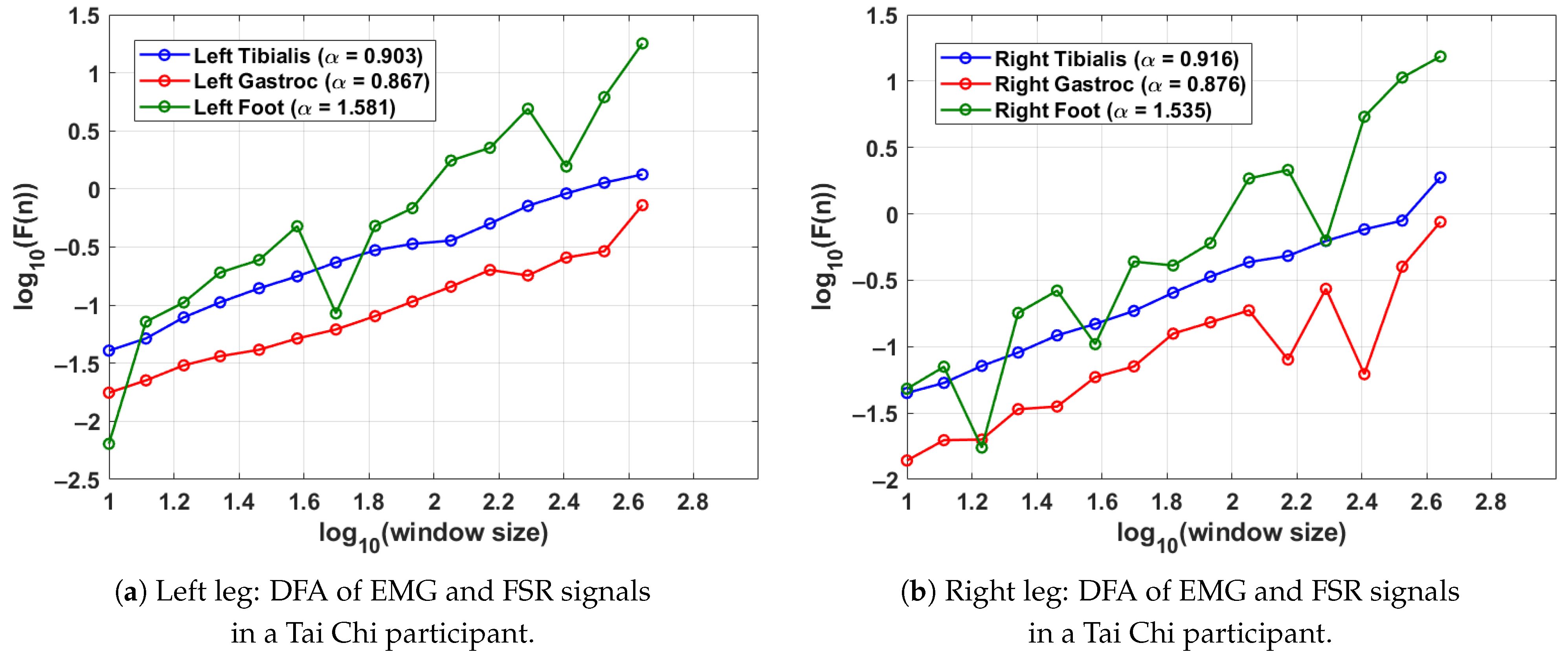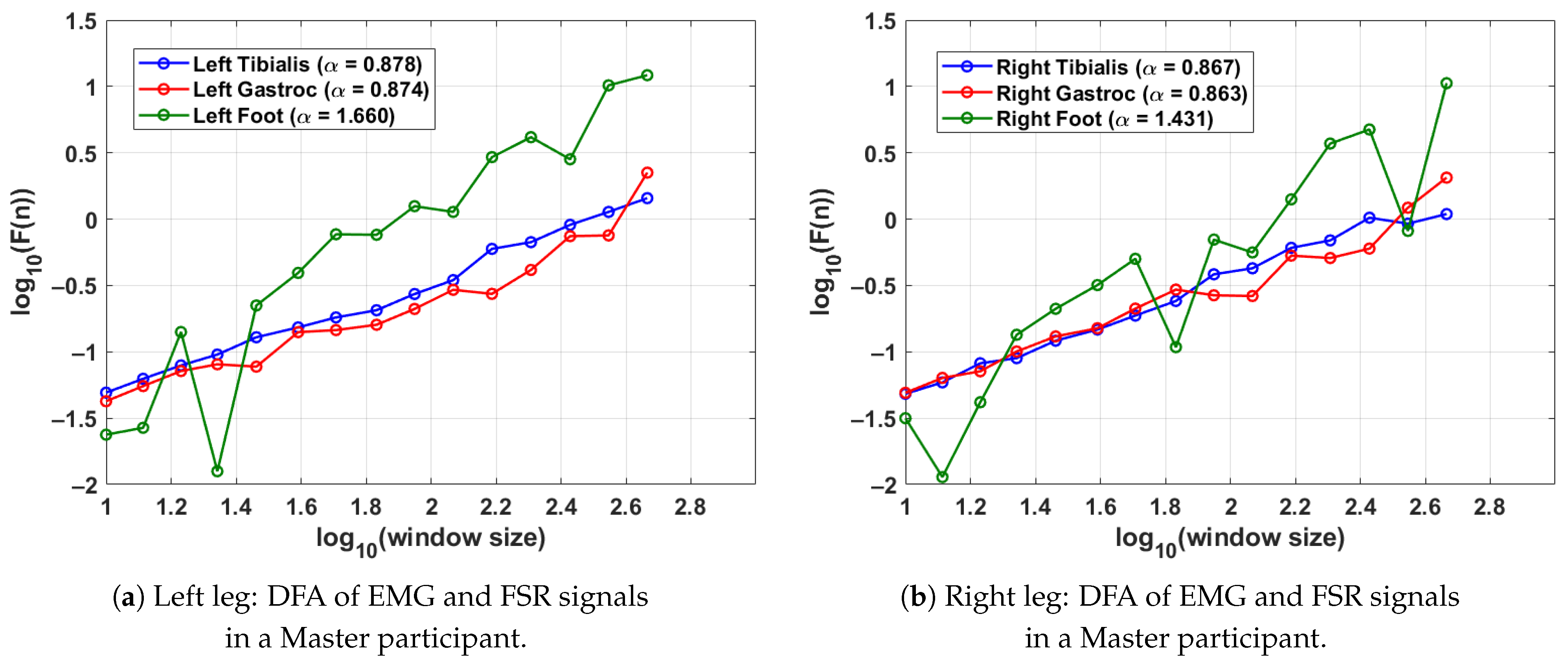Detrended Fluctuation Analysis of Gait Cycles: A Study of Neuromuscular and Ground Force Dynamics
Abstract
1. Introduction
2. Related Work
Problem Statement and Contributions
3. Methodology
3.1. Dataset Description and Participant Groups
3.2. FSR Sensor Signal Processing and DFA Computation
3.2.1. Gait Cycle Segmentation
3.2.2. DFA Computation
3.3. EMG Sensor Signal Processing and DFA Computation
3.3.1. Bandpass Filtering and Full-Wave Rectification
3.3.2. Gait Cycle Segmentation
3.3.3. DFA Computation
3.4. ANOVA and Interpretation
4. Experimental Results and Analysis
4.1. Synchronised FSR and EMG Sensor Signal Behaviour
4.2. DFA-Based Gait Analysis in Control Participants
4.3. DFA-Based Gait Analysis in Tai Chi Practitioner Participants
4.4. DFA-Based Gait Analysis in Tai Chi Master Participants
4.5. Comparison of DFA Values Across Groups
4.6. ANOVA Comparison of DFA Values Across Groups
5. Discussion
6. Conclusions
Author Contributions
Funding
Institutional Review Board Statement
Informed Consent Statement
Data Availability Statement
Conflicts of Interest
References
- Scafetta, N.; Marchi, D.; West, B.J. Understanding the complexity of human gait dynamics. Chaos Interdiscip. J. Nonlinear Sci. 2009, 19, 026108. [Google Scholar] [CrossRef]
- Verghese, J.; LeValley, A.; Hall, C.B.; Katz, M.J.; Ambrose, A.F.; Lipton, R.B. Epidemiology of gait disorders in community-residing older adults. J. Am. Geriatr. Soc. 2006, 54, 255–261. [Google Scholar] [CrossRef] [PubMed]
- Hausdorff, J.M.; Rios, D.A.; Edelberg, H.K. Gait variability and fall risk in community-living older adults: A 1-year prospective study. Arch. Phys. Med. Rehabil. 2001, 82, 1050–1056. [Google Scholar] [CrossRef]
- Figueiredo, B.; Frazão, Á.; Rouco, A.; Soares, B.; Albuquerque, D.; Pinho, P. A Review: Radar Remote-Based Gait Identification Methods and Techniques. Remote Sens. 2025, 17, 1282. [Google Scholar] [CrossRef]
- Rana, S.P.; Dey, M.; Ghavami, M.; Dudley, S. Non-contact human gait identification through IR-UWB edge-based monitoring sensor. IEEE Sens. J. 2019, 19, 9282–9293. [Google Scholar] [CrossRef]
- Rana, S.P.; Dey, M.; Ghavami, M.; Dudley, S. Signature inspired home environments monitoring system using IR-UWB technology. Sensors 2019, 19, 385. [Google Scholar] [CrossRef]
- Rana, S.P.; Dey, M.; Ghavami, M.; Dudley, S. Markerless gait classification employing 3D IR-UWB physiological motion sensing. IEEE Sens. J. 2022, 22, 6931–6941. [Google Scholar] [CrossRef]
- Rana, S.P.; Dey, M.; Ghavami, M.; Dudley, S. 3-D gait abnormality detection employing contactless IR-UWB sensing phenomenon. IEEE Trans. Instrum. Meas. 2021, 70, 6006510. [Google Scholar] [CrossRef]
- Rana, S.P.; Dey, M.; Ghavami, M.; Dudley, S. ITERATOR: A 3D gait identification from IR-UWB technology. In Proceedings of the 2019 41st Annual International Conference of the IEEE Engineering in Medicine and Biology Society (EMBC), Berlin, Germany, 23–27 July 2019; pp. 782–787. [Google Scholar]
- Wayne, P.M.; Walsh, J.N.; Taylor-Piliae, R.E.; Wells, R.E.; Papp, K.V.; Donovan, N.J.; Yeh, G.Y. Effect of Tai Chi on cognitive performance in older adults: Systematic review and meta-Analysis. J. Am. Geriatr. Soc. 2014, 62, 25–39. [Google Scholar] [CrossRef]
- Li, F.; Harmer, P.; Fisher, K.J.; McAuley, E.; Chaumeton, N.; Eckstrom, E.; Wilson, N.L. Tai Chi and fall reductions in older adults: A randomized controlled trial. J. Gerontol. Ser. A Biol. Sci. Med Sci. 2005, 60, 187–194. [Google Scholar] [CrossRef]
- Su, J.J.; Lin, R.S.; Batalik, L.; Abu-Odah, H.; Pepera, G.; Xu, Q.; Yeung, W.F. Effects of mind-body exercise on physical and psychosocial well-being of stroke patients: A systematic review and network meta-analysis. Geriatr. Nurs. 2024, 55, 346–353. [Google Scholar] [CrossRef] [PubMed]
- Lage, J.B.; Nascentes, G.A.N.; Silva, L.F.; Borges, M.C.; Ferreira, I.C.R.; Lombardi, L.A.; Silva, F.S.; Espindula, A.P. Electromyographic analysis of trunk and lower limb activation in children with cerebral palsy during gait and hippotherapy sessions. J. Bodyw. Mov. Ther. 2025, 43, 273–278. [Google Scholar] [CrossRef]
- Bhongade, A.; Gupta, R.; Bhatia, M.; Prathosh, A.P.; Gandhi, T.K. Classification of Gait Phases Using a Shank-Mounted Single IMU Sensor for Plane Level Walking. IEEE Sens. J. 2025, 25, 14183–14195. [Google Scholar] [CrossRef]
- Peng, C.K.; Havlin, S.; Stanley, H.E.; Goldberger, A.L. Quantification of scaling exponents and crossover phenomena in nonstationary heartbeat time series. Chaos Interdiscip. J. Nonlinear Sci. 1995, 5, 82–87. [Google Scholar] [CrossRef]
- Goldberger, A.L.; Amaral, L.A.; Glass, L.; Hausdorff, J.M.; Ivanov, P.C.; Mark, R.G.; Mietus, J.E.; Moody, G.B.; Peng, C.K.; Stanley, H.E. PhysioBank, PhysioToolkit, and PhysioNet: Components of a new research resource for complex physiologic signals. Circulation 2000, 101, e215–e220. [Google Scholar] [CrossRef] [PubMed]
- Hausdorff, J.M.; Purdon, P.L.; Peng, C.K.; Ladin, Z.; Wei, J.Y.; Goldberger, A.L. Fractal dynamics of human gait: Stability of long-range correlations in stride interval fluctuations. J. Appl. Physiol. 1996, 80, 1448–1457. [Google Scholar] [CrossRef] [PubMed]
- Näf, O.B.; Bauer, C.M.; Zange, C.; Rast, F.M. Validity and variability of center of pressure measures to quantify trunk control in stroke patients during quiet sitting and reaching tasks. Gait Posture 2020, 76, 218–223. [Google Scholar] [CrossRef]
- Wayne, P.M.; Kaptchuk, T.J. Challenges inherent to t’ai chi research: Part I—t’ai chi as a complex multicomponent intervention. J. Altern. Complement. Med. 2008, 14, 95–102. [Google Scholar] [CrossRef]
- Wu, G. Evaluation of the effectiveness of Tai Chi for improving balance and preventing falls in the older population—A review. J. Am. Geriatr. Soc. 2002, 50, 746–754. [Google Scholar] [CrossRef]
- Manor, B.; Costa, M.D.; Hu, K.; Newton, E.; Starobinets, O.; Kang, H.G.; Peng, C.; Novak, V.; Lipsitz, L.A. Physiological complexity and system adaptability: Evidence from postural control dynamics of older adults. J. Appl. Physiol. 2010, 109, 1786–1791. [Google Scholar] [CrossRef]
- Winter, D.A. Biomechanics and Motor Control of Human Gait: Normal, Elderly and Pathological; University of Waterloo Press: Waterloo, ON, Canada, 1991. [Google Scholar]
- Bamberg, S.J.M.; Benbasat, A.Y.; Scarborough, D.M.; Krebs, D.E.; Paradiso, J.A. Gait analysis using a shoe-integrated wireless sensor system. IEEE Trans. Inf. Technol. Biomed. 2008, 12, 413–423. [Google Scholar] [CrossRef] [PubMed]
- Mason, R.; Pearson, L.T.; Barry, G.; Young, F.; Lennon, O.; Godfrey, A.; Stuart, S. Wearables for running gait analysis: A systematic review. Sports Med. 2023, 53, 241–268. [Google Scholar] [CrossRef]
- Piryonesi, S.M.; Rostampour, S.; Piryonesi, S.A. Predicting falls and injuries in people with multiple sclerosis using machine learning algorithms. Mult. Scler. Relat. Disord. 2021, 49, 102740. [Google Scholar] [CrossRef]
- Phinyomark, A.; Quaine, F.; Charbonnier, S.; Serviere, C.; Tarpin-Bernard, F.; Laurillau, Y. EMG feature evaluation for improving myoelectric pattern recognition robustness. Expert Syst. Appl. 2013, 40, 4832–4840. [Google Scholar] [CrossRef]
- Kirchner, M.; Schubert, P.; Liebherr, M.; Haas, C.T. Detrended fluctuation analysis and adaptive fractal analysis of stride time data in Parkinson’s disease: Stitching together short gait trials. PLoS ONE 2014, 9, e85787. [Google Scholar] [CrossRef] [PubMed]
- Kang, H.G.; Dingwell, J.B. Effects of walking speed, strength and range of motion on gait stability in healthy older adults. J. Biomech. 2008, 41, 2899–2905. [Google Scholar] [CrossRef]
- Lee, Y.; Kim, G.B.; Shin, S. Association Between Lower Limb Strength Asymmetry and Gait Asymmetry: Implications for Gait Variability in Stroke Survivors. J. Clin. Med. 2025, 14, 380. [Google Scholar] [CrossRef]
- Costa, M.; Goldberger, A.L.; Peng, C.K. Multiscale entropy analysis of biological signals. Phys. Rev. E—Stat. Nonlinear Soft Matter Phys. 2005, 71, 021906. [Google Scholar] [CrossRef]
- Wayne, P.; Gow, B.; Hausdorff, J.; Peng, C.K.; Lipsitz, L.; Ahn, A.; Novak, V.; Manor, B. Tai Chi, Physiological Complexity, and Healthy Aging-Gait. PhysioNet 2021. [Google Scholar] [CrossRef]
- Wayne, P.M.; Manor, B.; Novak, V.; Costa, M.D.; Hausdorff, J.M.; Goldberger, A.L.; Ahn, A.C.; Yeh, G.Y.; Peng, C.K.; Lough, M.; et al. A systems biology approach to studying Tai Chi, physiological complexity and healthy aging: Design and rationale of a pragmatic randomized controlled trial. Contemp. Clin. Trials 2013, 34, 21–34. [Google Scholar] [CrossRef]








| Signal | Control | Tai Chi | Master |
|---|---|---|---|
| Right Tibialis Anterior | |||
| Right Lateral Gastrocnemius | |||
| Right Foot (FSR) |
Disclaimer/Publisher’s Note: The statements, opinions and data contained in all publications are solely those of the individual author(s) and contributor(s) and not of MDPI and/or the editor(s). MDPI and/or the editor(s) disclaim responsibility for any injury to people or property resulting from any ideas, methods, instructions or products referred to in the content. |
© 2025 by the authors. Licensee MDPI, Basel, Switzerland. This article is an open access article distributed under the terms and conditions of the Creative Commons Attribution (CC BY) license (https://creativecommons.org/licenses/by/4.0/).
Share and Cite
Rana, S.P.; Dey, M. Detrended Fluctuation Analysis of Gait Cycles: A Study of Neuromuscular and Ground Force Dynamics. Sensors 2025, 25, 4122. https://doi.org/10.3390/s25134122
Rana SP, Dey M. Detrended Fluctuation Analysis of Gait Cycles: A Study of Neuromuscular and Ground Force Dynamics. Sensors. 2025; 25(13):4122. https://doi.org/10.3390/s25134122
Chicago/Turabian StyleRana, Soumya Prakash, and Maitreyee Dey. 2025. "Detrended Fluctuation Analysis of Gait Cycles: A Study of Neuromuscular and Ground Force Dynamics" Sensors 25, no. 13: 4122. https://doi.org/10.3390/s25134122
APA StyleRana, S. P., & Dey, M. (2025). Detrended Fluctuation Analysis of Gait Cycles: A Study of Neuromuscular and Ground Force Dynamics. Sensors, 25(13), 4122. https://doi.org/10.3390/s25134122








